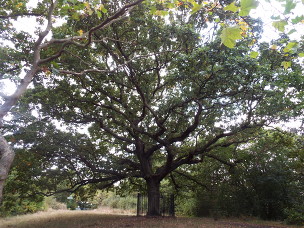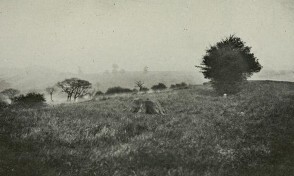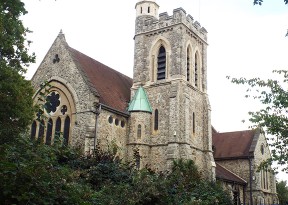





Exploring Southwark and discovering its history


The hill had long been used by the public as a recreation ground and a short-cut but in 1896, without warning, a six foot high fence was erected that enclosed the hill and excluded the general public. The fence had been installed by the adjoining Honor Oak and Forest Hill Golf Club who were leaseholders of the land. The action caused a storm of protest and led to the formation of the Enclosure of Honor Hill Protest Committee whose numbers included many residents of local standing. They originally based their argument on the public’s common rights to the land but this was later changed to argue the public had rights of way. So began a long tortuous process that was not finally resolved until 1905.
There were those who were impatient with the slow progress of resolving the matter by constitutional means and who wished to take more direct action. They attempted to persuade the Protest Committee to test the rights of the Golf Club by breaking down the fence and forcing entry. The Committee refused to use such tactics. Nevertheless on Sunday 10th October 1897 a crowd of 15,000 gathered around the hill. Some began attacking the fence and pulled down a section and entered upon the hill which proved a general signal for a general rush onto the hill. “The Hill was soon covered with a disorderly multitude.” Local dignitaries present denounced the behaviour as not being in the best interests of the attempts to claim the hill for the public and after singing “Rule Britannia” at the top of the hill, the crowd dispersed quietly.
A week later, a larger crowd of between 50,000 to 1000,000 gathered, together with 500 police, both on foot and mounted. The police managed to prevent any damage to the fence but there were incidents of stone throwing and furze being set alight. Rushes on the fences by the crowd were countered by charges by the police. In total ten people were arrested who received sentences that varied from one month’s imprisonment to a £2 fine. A crowd of a few thousand gathered on the third Sunday but this was the last attempt at this type of action.
The Protest Committee received support from the Commons and Footpaths Preservation Society and evidence gathered was presented to a Committee that had been set up jointly by the Camberwell and Lewisham vestries as the boundary for the two vestries then cut right across the hill. In March 1899 the Joint Committee announced their recommendation which was that their respective vestries should take legal advice. The long awaited legal report found that while the Protest Committee had a case for two of the paths in question to be classified as rights of way, the case was not strong enough to go to Court.
In 1901 the vestry boundaries were changed and the whole area of the hill was now within the jurisdiction of the Borough Council of Camberwell. They arranged with the London County Council to insert a clause into the General Powers Bill 1902 for the compulsory purchase of One Tree Hill. Mr Ward, who was now the owner of the hill, had been very obstructive regarding the purchase and claimed he was due £16,000 as the land could be used for building upon. Camberwell Council refuted this and the final sum agreed was £6,100, £1,000 of which came from an anonymous donation received by the Commons Preservation and Footpaths Preservation Society. One Tree Hill was now at last in the ownership of Camberwell Council and thanks to both their actions and the Protest Committee is dedicated to free use by the public forever.
Source: The Story of the One Tree Hill Agitation by Councillor John Nisbet (Member of the Protest Committee
The One Tree Hill public recreation ground was formally opened on 7 August 1905 at which occasion thanks were given to those who had worked towards ensuring the hill remained open to the public and the present oak tree was planted. For more information about One Tree Hill today, visit the Friends of One Tree Hill website.
One Tree Hill
The Hill of Honor Oak, popularly known as One Tree Hill, is close to the Southwark and Lewisham border and a vantage point for some of the best views of central London. One Tree Hill belies its name as it now has an abundance of trees and is a designated nature conservation area, but there is one special tree at the summit, the Oak of Honor, now protected by railings.



It is said a tree was planted in the eleventh century to mark the southern boundary of the lands belonging to the Honour of Gloucester and this is how the hill got its name. Others say that the tree was called the Oak of Honor after Queen Elizabeth I rested in its shadow and took refreshments on May Day 1602 during a visit Sir Richard Buckley at Lewisham.
At the beginning of the 19th century, the high vantage point from the hill was used as a semaphore station by the East India Company from where the sightings of their ships arriving in the Channel were signalled. The station was requisitioned by the Admiralty at the time of Napoleon’s threatened invasion of England and a cottage for the use of the signalling operator was built on top of the hill.
The church of St Augustine was built on the southern slope of the hill in 1873 on land donated by a resident who also gave £700 towards the construction of the church.
At the turn of the 19th and 20th centuries, the hill was forested to the south and west but there were very few trees on the north side. A part of the railway line that ran from Crystal Palace high level station to Nunhead ran at the bottom of the hill to the north (now the former train line forms a part of Brenchley Gardens) and there was a station called Honor Oak situated on Wood Vale, now, like the railway line, demolished without a trace. There was a stump of an old tree said to be the remains of the second tree planted since the days of Queen Elizabeth I that had been struck by lightning in the 1880s.
One Tree Hill before the planting of the existing tree in 1905
Web discoveries
- UK Casino Not On Gamstop
- UK Casino Not On Gamstop
- Non Gamstop Casino
- Casinos Not On Gamstop
- Non Gamstop Casinos
- Non Gamstop Casinos
- Non Gamstop Casino
- Casino Sites Not On Gamstop
- Slots Not On Gamstop
- Casinos Not On Gamstop
- UK Betting Sites Not On Gamstop
- UK Casino Not On Gamstop
- Best Non Gamstop Casinos
- Betting Sites
- Non Gamstop Casino Sites UK
- Best Non Gamstop Casinos
- Non Gamstop Casino
- Casinos Not On Gamstop
- Non Gamstop Casino Sites UK